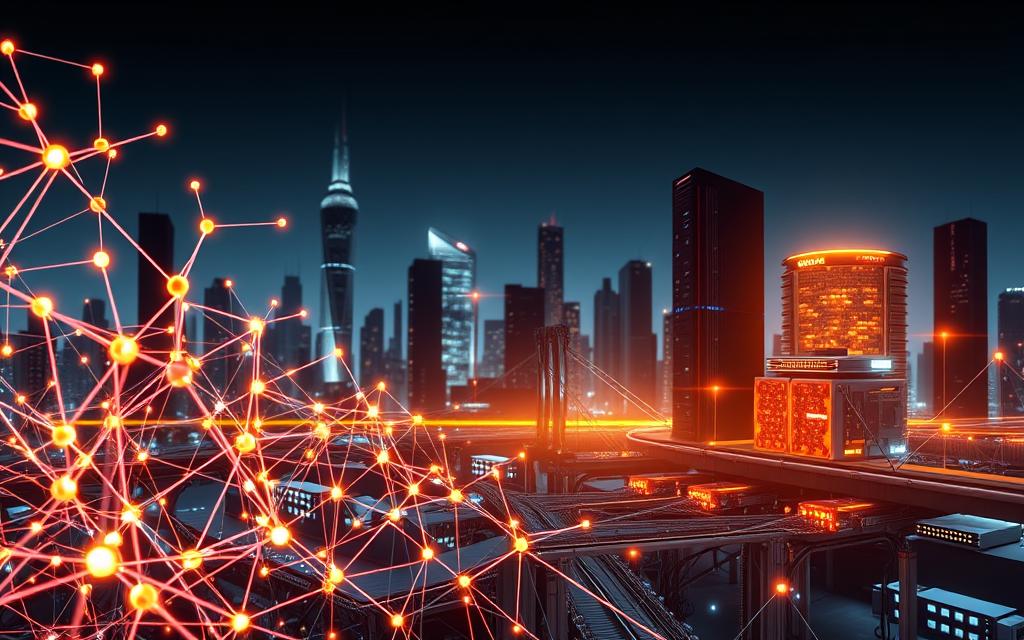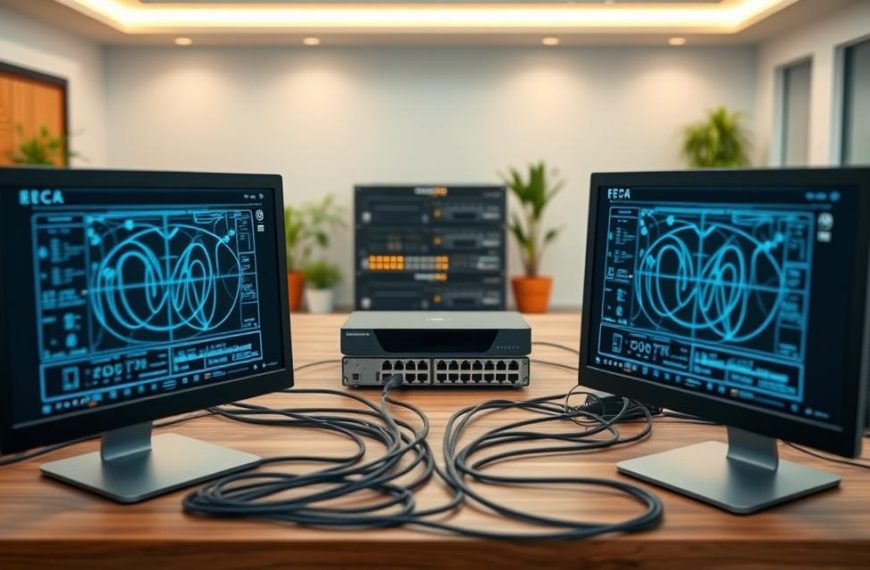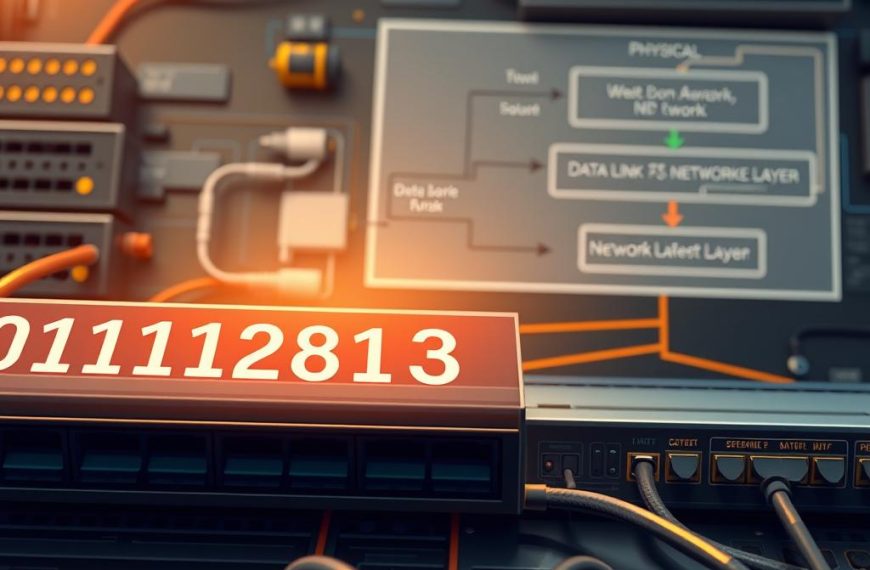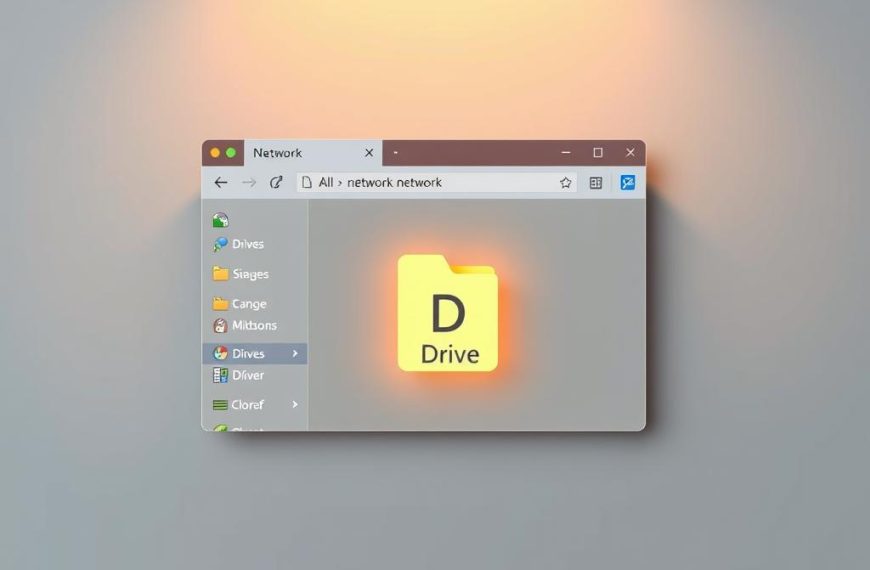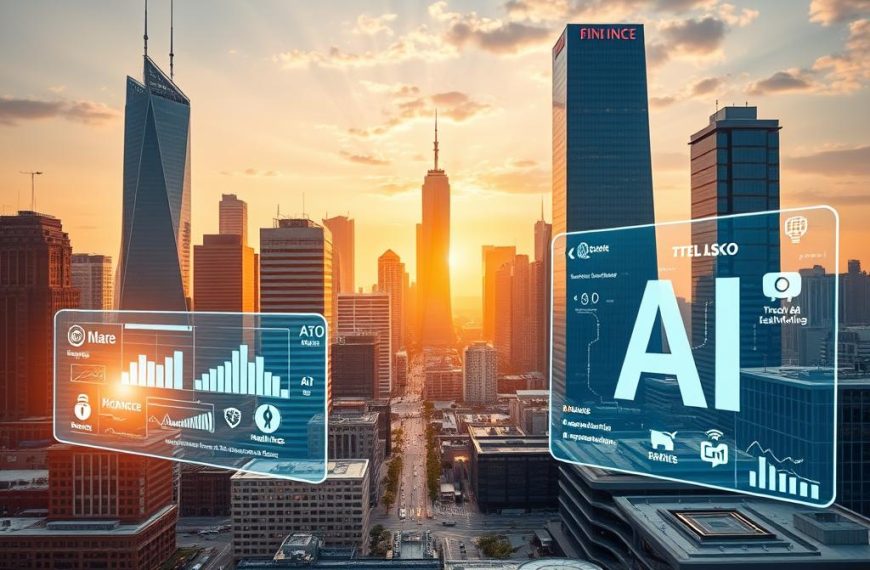Artificial intelligence relies heavily on neural networks to power advanced systems. From speech recognition to machine translation, these models mimic human learning processes. Their origins trace back over 70 years, far preceding modern computer networks.
Both systems share a foundational concept: interconnected nodes. However, their purposes diverge significantly. While one specializes in pattern recognition, the other focuses on data routing. MIT research confirms that GPU acceleration revolutionized deep learning capabilities.
Google’s search algorithms demonstrate real-world applications of these technologies. This article explores their evolutionary paths, architectural contrasts, and practical implementations across industries.
Understanding Neural Networks and Computer Networks
The digital age thrives on systems that either learn patterns or transmit information. While both rely on interconnected nodes, their purposes diverge sharply. One mimics human cognition, while the other enables global communication.
What Is a Neural Network?
Modeled after biological brains, neural networks process data through layered architectures. Warren McCullough and Walter Pitts first proposed this concept in 1943, inspired by neurons firing signals.
Key components include:
- Input layer: Receives raw data (e.g., pixels, sound waves).
- Hidden layers: Transform data using weights and activation functions.
- Output layer: Delivers predictions (e.g., speech-to-text results).
Frank Rosenblatt’s 1958 Perceptron marked the first trainable model. Today, Google uses 50-layer deep learning networks for search algorithms.
What Is a Computer Network?
Unlike AI systems, computer networks focus on data exchange between devices. They rely on physical infrastructure (cables, routers) and protocols like TCP/IP.
Common topologies include:
- Star: Central hub manages nodes.
- Mesh: Direct connections between all devices.
MIT research highlights how feed-forward designs in both systems optimize efficiency—whether for learning or data routing.
Key Components of Neural Networks
Modern AI systems depend on layered architectures to process complex data patterns. These structures transform raw inputs into actionable insights through interconnected computational units. Three core elements drive this process.
Input Layers and Hidden Layers
The input layer receives raw data like images or text. Each node represents a feature, such as pixel intensity in photos. This tier passes information to subsequent hidden layers for deeper analysis.
Hidden tiers use activation functions like ReLU or sigmoid to detect patterns. Fukushima’s 1969 ReLU design remains pivotal for introducing non-linearity. Deeper tiers identify complex features—edges in CNNs evolve into recognizable objects.
Weights and Activation Functions
Weights determine connection strength between nodes. During training, gradient descent adjusts these values to minimize errors. IBM’s surfing analogy illustrates how thresholds filter irrelevant data.
Activation functions decide if a node fires signals. Sigmoid outputs probabilities (0-1), while ReLU handles vanishing gradients efficiently. These functions enable models to learn non-linear relationships.
Output Layers and Backpropagation
The output layer delivers final predictions, like classifying handwritten digits. Paul Werbos’ 1982 backpropagation algorithm refines accuracy by reversing error signals.
Yann LeCun’s 1989 ZIP code recognizer demonstrated this method’s power. Modern systems stack dozens of layers, contrasting Rosenblatt’s single-layer Perceptron.
Key Components of Computer Networks
Global communication depends on structured systems to move data efficiently. Unlike neural networks, which simulate learning, these frameworks prioritize speed and reliability. Their architecture ensures seamless information exchange across devices.
Nodes and Connections
Routers, servers, and IoT devices serve as critical nodes. Each one processes and routes data packets, similar to neurons firing signals. Mesh topologies allow direct communication, while star layouts centralize control.
Key differences from neural systems:
- Nodes in computer networks are physical devices.
- Connections rely on cables or wireless signals, not weighted links.
Protocols and Data Transmission
TCP/IP protocols standardize data transmission, ensuring packets arrive intact. The OSI model’s seven layers mirror neural processing tiers but focus on delivery, not analysis.
| OSI Layer | Neural Network Equivalent |
|---|---|
| Physical (Layer 1) | Input Layer (raw data reception) |
| Transport (Layer 4) | Hidden Layers (data transformation) |
| Application (Layer 7) | Output Layer (user-facing results) |
Packet switching optimizes bandwidth, while CRC checks for errors—contrasting with backpropagation’s weight adjustments. Latency reduction strategies, like caching, parallel neural inference speeds.
How Is a Neural Network Like a Computer Network?
Parallel architectures power both cognitive models and global data exchange. Despite differing goals, their designs share striking similarities in efficiency and adaptability. MIT’s research confirms GPU-accelerated processing benefits both fields.
- Nodes that handle distributed tasks, whether for learning or routing.
- Scalability through added layers (neural) or devices (computer).
- Fault tolerance via redundant pathways, ensuring uninterrupted operations.
Cisco’s neural-inspired algorithms optimize traffic flow, mirroring weight adjustments in AI models. Both systems transform data through sequential stages—packets in routers or signals in hidden tiers.
| Feature | Neural Networks | Computer Networks |
|---|---|---|
| Core Unit | Neuron (node) | Router/server (node) |
| Optimization Method | Backpropagation | Adaptive routing |
| Hardware | GPUs/TPUs | Switches/fiber optics |
Neuromorphic chips now blur these lines further. Intel’s Loihi mimics synaptic plasticity, while neural networks inspire smarter load-balancing protocols. The future lies in cross-disciplinary innovation.
Fundamental Differences Between Neural and Computer Networks
Cognitive models and communication frameworks solve distinct problems in modern computing. While both process information, their architectures prioritize opposing objectives. IBM’s image classifiers demonstrate how one system evolves through machine learning, while 5G networks showcase the other’s transmission reliability.
Purpose and Functionality
Neural systems specialize in pattern recognition through layered algorithms. They adjust internal weights during training to minimize errors in tasks like speech translation. Google’s BERT model exemplifies this adaptive learning approach.
Computer networks prioritize deterministic data delivery. Their protocols ensure packets reach destinations intact, measured by metrics like:
- Packet loss rates (below 1% for VoIP)
- Latency thresholds (under 150ms for gaming)
Learning Versus Transmission
Temporal differences separate these technologies. Neural models require extensive training epochs—sometimes weeks on GPU clusters.
“Deep learning systems trade immediate results for long-term accuracy gains,”
notes an MIT researcher.
In contrast, computer networks operate in real-time. Their performance table highlights key contrasts:
| Metric | Neural Networks | Computer Networks |
|---|---|---|
| Optimization Target | Loss function reduction | Bandwidth utilization |
| Resource Priority | GPU memory allocation | Router buffer capacity |
| Security Approach | Adversarial training | IPsec encryption |
These divergent needs shape hardware investments. While AI demands tensor processors, network engineers prioritize fiber optic backbones. Both fields advance through specialized algorithms, yet solve fundamentally different challenges.
The Role of Layers in Neural Networks
Feature extraction evolves through hierarchical architectures. Layers transform raw data into actionable insights, mirroring human cognitive processes. Fukushima’s 1979 convolutional neural networks pioneered this with max pooling, enabling spatial hierarchy in image analysis.
Depth directly impacts abstraction capabilities. IBM’s experiments show 50-layer models outperform shallow 3-tier designs in complex tasks like object recognition. Each hidden layer refines features—edges become shapes, then recognizable objects.
Challenges emerge with ultra-deep structures. The vanishing gradient problem stalled early deep neural progress until LSTMs introduced memory gates in 1993. These units preserve error signals across time steps, critical for speech and text analysis.
Modern breakthroughs like Transformers rely on attention mechanisms. Instead of fixed hierarchies, they dynamically weight input importance. This innovation powers Google’s BERT and OpenAI’s GPT models.
- Feedforward: Data flows one-way (input → output), ideal for static patterns.
- Recurrent: Loops enable temporal analysis, used in stock prediction.
NVIDIA’s StyleGAN demonstrates progressive layer training—starting low-resolution, then adding detail. ResNet’s 2015 residual connections enabled 1,000+ layers by bypassing redundant computations.
“Depth without degradation requires innovative skip connections,”
notes a lead AI researcher at MIT. Architectural choices now balance complexity against computational costs, shaping next-gen AI tools.
Data Flow in Computer Networks
Protocols govern how bits travel across global systems. Unlike neural architecture, which processes information hierarchically, networks prioritize reliable delivery. The OSI model’s seven layers mirror deep learning frameworks but serve different purposes.
| OSI Layer | Neural Function |
|---|---|
| Network (Layer 3) | Weights adjustment (path selection) |
| Transport (Layer 4) | Backpropagation (error correction) |
| Session (Layer 5) | Attention mechanisms (priority routing) |
TCP’s congestion control resembles neural regularization. Both algorithms prevent overload—packet drops act like dropout layers in deep learning. Google’s BBR protocol adapts rates dynamically, similar to adaptive learning optimizers.
Software-Defined Networking (SDN) introduces programmability. Centralized controllers adjust flows like neural parameter servers. This enables:
- Real-time traffic shaping (analogous to batch normalization)
- Security policies that mimic adversarial training
Edge computing distributes processing closer to users. MobileNets demonstrate similar decentralization, optimizing for low-latency inference. Content Delivery Networks (CDNs) cache frequently accessed data, mirroring how neural models reuse learned features.
“QoS mechanisms in routers function like attention heads—prioritizing critical traffic streams,”
explains a Cisco engineer. These innovations show how networking evolves by borrowing concepts from cognitive systems.
Training Neural Networks: How Learning Happens
Teaching machines to recognize patterns requires structured learning processes. Unlike traditional programming, training data shapes a model’s decision-making abilities through iterative adjustments. The 2012 AlexNet breakthrough demonstrated this, achieving record accuracy with ImageNet’s 14 million labeled images.
Supervised vs. Unsupervised Learning
Supervised machine learning relies on labeled datasets, like IBM’s MNIST for digit recognition. The system compares predictions against known answers, refining weights through backpropagation. Think of it as a student receiving graded exams.
Unsupervised methods discover hidden patterns in raw data. Clustering algorithms group similar inputs without predefined categories. MIT research shows these techniques excel in anomaly detection and customer segmentation.
- Batch learning: Processes entire datasets before updating weights
- Online learning: Adjusts parameters per data point for real-time adaptation
The Role of Training Data
Quality datasets fuel effective learning algorithms. Data augmentation techniques expand limited samples—rotating images or adding noise creates synthetic variations. IBM’s Watson used curated medical journals to train its diagnostic models.
| Dataset Type | Use Case |
|---|---|
| Labeled (Supervised) | Speech recognition, object detection |
| Unlabeled (Unsupervised) | Market basket analysis, fraud detection |
“Transfer learning cuts training time by 70% when adapting pre-trained models to new tasks,”
notes a Google AI engineer. Modern deep learning frameworks leverage this approach, building on architectures like ResNet rather than starting from scratch.
How Computer Networks Handle Data
Efficient data movement defines modern digital infrastructure. Systems rely on advanced processing techniques to route billions of bits globally. Below are core mechanisms powering this flow.
Packet Switching Fundamentals
Messages split into smaller packets for transmission. Each unit travels independently via optimal paths, reassembling at the destination. This method maximizes bandwidth usage and minimizes latency.
HTTP/3 vs. QUIC Protocols
Google’s QUIC protocol reduces connection times by 30% compared to HTTP/2. Key improvements include:
- Multiplexing without head-of-line blocking
- Built-in encryption via TLS 1.3
5G Network Slicing
Carriers partition bandwidth for specific needs—autonomous vehicles get low-latency slices, while IoT devices share high-capacity segments. This algorithm optimizes resource allocation dynamically.
| Protocol | Reliability | Use Case |
|---|---|---|
| TCP | High (retransmits lost packets) | Web browsing, email |
| UDP | Low (no error correction) | Video streaming, VoIP |
Blockchain’s Distributed Ledger
Nodes validate transactions collectively, eliminating central authorities. Each block cryptographically links to the previous one, creating tamper-proof information chains.
“Onion routing anonymizes traffic by encrypting data through multiple relay nodes,”
explains a Tor Project developer. This layered approach mirrors 5G slicing but prioritizes privacy over speed.
Real-World Applications of Neural Networks
Cutting-edge technologies now transform industries through advanced pattern analysis. From healthcare to entertainment, neural networks drive innovations once deemed impossible. Google’s 2015 milestone proved machines could outperform humans in image recognition, a turning point for AI adoption.
Healthcare breakthroughs showcase their potential. IBM Watson analyzes medical scans with convolutional neural networks, detecting tumors earlier than traditional methods. DeepMind’s AlphaFold solves protein-folding puzzles, accelerating drug discovery.
Everyday tools rely on these systems too:
- Speech recognition powers virtual assistants like Siri and Alexa
- Netflix’s recommendation engine personalizes content using viewing patterns
- Banks deploy fraud detection models that flag suspicious transactions in milliseconds
Industrial sectors benefit equally. Predictive maintenance algorithms analyze sensor data, preventing equipment failures. Autonomous vehicles process real-time inputs—pedestrians, traffic signs—through layered neural architectures.
“GPT-4’s language generation mimics human creativity, drafting legal contracts or poetry with equal finesse,”
notes an OpenAI researcher. These applications underscore how deeply AI integrates into modern workflows.
Real-World Applications of Computer Networks
Digital connectivity powers modern civilization through invisible infrastructure. Computer networks enable everything from global finance to remote education, transforming how we live and work. These systems form the backbone of today’s most impactful technologies.
Cloud computing platforms like AWS and Azure demonstrate scalability. Enterprises deploy virtual servers worldwide, accessing resources on-demand. This flexibility supports:
- Instant software updates for millions of users
- Disaster recovery through geographically distributed backups
- AI model training using elastic GPU clusters
Smart cities showcase IoT implementations. Connected sensors manage traffic lights, reducing congestion by 25% in pilot programs. Utilities monitor power grids through mesh networks, preventing blackouts.
| Application | Key Technology | Impact |
|---|---|---|
| Telemedicine | 5G low-latency connections | Real-time surgeon consultations |
| Cryptocurrency | Blockchain peer-to-peer protocols | Decentralized financial transactions |
| Remote Work | VPN tunneling | Secure access to corporate resources |
Content delivery networks like Akamai accelerate media streaming. By caching files at edge locations, they cut load times by 50%. This technology enables buffer-free 4K video worldwide.
Emerging satellite constellations revolutionize internet access. SpaceX’s Starlink delivers broadband to rural areas through thousands of low-orbit nodes. These systems bridge the digital divide where fiber optics can’t reach.
“Network slicing in 5G allows customized virtual networks for different industries on shared infrastructure,”
explains a Verizon engineer. From autonomous vehicles to augmented reality, these applications demonstrate networking’s transformative potential.
The Evolution of Neural Networks
Decades of research transformed simple mathematical models into powerful cognitive systems. This journey from theoretical concepts to practical machine learning tools reshaped artificial intelligence. Key breakthroughs propelled each stage of development.
Early Foundations and Breakthroughs
Warren McCulloch and Walter Pitts laid the groundwork in 1943 with their neuron model. Their electrical circuit design mimicked basic brain functions. Frank Rosenblatt’s 1958 Perceptron introduced trainable weights, enabling pattern recognition.
Major milestones include:
- Backpropagation (1986): Revolutionized training for multi-layer networks
- Convolutional Neural Networks (1989): Yann LeCun’s breakthrough for image processing
- LSTMs (1997): Jürgen Schmidhuber’s solution for sequential data analysis
The Deep Learning Revolution
GPU acceleration enabled training of complex deep neural architectures. The 2012 ImageNet competition proved this when AlexNet outperformed traditional methods. This victory sparked widespread AI adoption.
| Era | Innovation | Impact |
|---|---|---|
| 2000s | GPU acceleration | 100x faster training times |
| 2010s | Generative Adversarial Networks | Realistic image synthesis |
| 2020s | Transformer architectures | Advanced language models |
Ian Goodfellow’s 2014 GANs introduced competitive learning between networks. This algorithm enabled photorealistic image generation and data augmentation.
“Neuromorphic chips like IBM’s TrueNorth mimic biological neurons with unprecedented efficiency,”
notes a senior researcher. These developments continue pushing boundaries in AI capabilities.
The Evolution of Computer Networks
Digital infrastructure has undergone radical transformations since the 1960s. What began as military research projects now powers global commerce and communication. This journey from ARPANET to 5G demonstrates remarkable technological progress.
Early networks relied on circuit-switched telephone lines. The 1969 ARPANET breakthrough introduced packet switching—a foundational architecture still used today. Key milestones include:
- TCP/IP standardization (1983) enabling internetworking
- World Wide Web creation (1989) democratizing information access
- Fiber optic adoption (1990s) boosting bandwidth capacities
Modern innovations focus on flexibility and speed. Software-Defined Networking (SDN) separates control and data planes, allowing programmable traffic management. Cloud providers leverage this for dynamic resource allocation.
| Generation | Key Innovation | Impact |
|---|---|---|
| 2G | Digital signals | Mobile voice calls |
| 4G LTE | IP-based protocols | Mobile video streaming |
| 5G | Network slicing | Ultra-low latency applications |
Edge computing represents another paradigm shift. By moving processing closer to users, systems reduce latency for IoT devices and autonomous vehicles. Content Delivery Networks (CDNs) exemplify this approach.
Emerging technologies promise further disruption. Quantum networks could enable unhackable communication through entanglement. IPv6 adoption addresses address exhaustion while introducing enhanced security features.
“Network function virtualization will replace 80% of physical appliances by 2025,”
predicts a Cisco technical director. This evolution continues reshaping how data moves across digital ecosystems.
Future Trends in Neural and Computer Networks
The next decade will witness unprecedented convergence between cognitive computing and networking. MIT’s liquid neural networks research demonstrates how adaptive architectures outperform rigid designs. Simultaneously, IBM’s quantum machine learning initiatives bridge physics and AI.
- Neuromorphic hardware: Intel’s Loihi 2 chips simulate 1 million neurons with 10,000x efficiency gains
- Federated learning: Google’s approach trains models on decentralized devices while preserving privacy
- 6G-AI fusion: Nokia Bell Labs prototypes show 1ms latency for real-time neural inference
Photonic breakthroughs are accelerating both fields. Light-based deep learning systems process data at 10Gbps with minimal heat. IBM’s experimental optical routers reduce network energy use by 60%.
| Technology | Neural Impact | Network Impact |
|---|---|---|
| Quantum Computing | Faster optimization of complex models | Unbreakable encryption protocols |
| AI-Driven Optimization | Automated hyperparameter tuning | Self-healing network topologies |
| Edge AI | Localized model inference | Reduced cloud dependency |
Ethical frameworks are emerging alongside these advances. The EU’s AI Act mandates transparency for high-risk algorithms. Stanford researchers propose certification systems for bias-free neural architectures.
“Network-aware AI will become as essential as electricity for digital infrastructure,”
predicts an MIT Technology Review analysis. This symbiotic future promises smarter systems and more intelligent connections.
Conclusion
Modern technology thrives on the synergy between neural networks and computer networks. While one excels at pattern recognition, the other ensures seamless data transmission. Together, they power innovations from smart cities to AI-driven healthcare.
These systems complement each other in real-world applications. IBM’s hybrid research shows how edge computing merges both technologies for faster decision-making. Responsible development remains crucial as these fields evolve.
For deeper learning, explore certified courses in data analytics. The future promises even tighter integration, reshaping industries and daily life.

